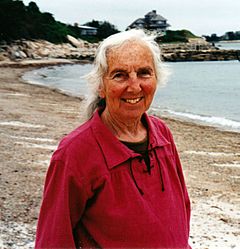Ruth Hubbard facts for kids
Quick facts for kids
Ruth Hubbard
|
|
|---|---|

Hubbard in Woods Hole, Massachusetts
|
|
| Born |
Ruth Hoffmann
March 3, 1924 Vienna, Austria
|
| Died | September 1, 2016 (aged 92) Cambridge, Massachusetts, U.S.
|
| Alma mater | Radcliffe College |
| Spouse(s) |
Frank Hubbard
(m. 1942–1951) |
| Children | Elijah Wald Deborah Hannah Wald |
| Awards | Paul Karrer Gold Medal |
| Scientific career | |
| Fields | Biology |
| Institutions | Harvard University |
Ruth Hubbard (March 3, 1924 – September 1, 2016) was a famous professor of biology at Harvard University. She was the first woman to become a tenured (permanent) biology professor there.
From the 1940s to the 1960s, she did important research. She helped us understand how our eyes see. This included how chemicals and light work together in the eyes of animals. In 1967, she and George Wald won the Paul Karrer Gold Medal for their work.
Later in the 1960s, she became more interested in social issues. She also became an activist.
Contents
Early Life and Education
Ruth Hoffmann was born in Vienna, Austria, in 1924. Her parents, Richard and Helene Hoffmann, were both doctors. They were also thinkers who believed in social equality. Her mother was a talented piano player. Ruth also showed musical talent when she was young.
In 1938, Nazi Germany took over Austria. The Hoffmann family moved to the United States to escape. They first lived in Brookline, Massachusetts. Ruth finished high school there. Then they moved to Cambridge.
Choosing a Path in Science
Ruth decided to go to Radcliffe College. She planned to study medicine. She said this was because many people around her were doctors. At that time, Radcliffe was connected to Harvard. Women were not yet allowed to study directly at Harvard University.
Ruth noticed that Harvard professors sometimes seemed annoyed. They had to travel to Radcliffe to teach smaller classes for women. They had already taught the same lessons to male students at Harvard. But by 1946, most classes were for both men and women. Harvard professors taught these classes.
For a short time, Ruth thought about studying Philosophy and Physics. She felt like she was not welcome in Physics. She was one of only two women in a large physics class of 350 students. This made her feel uncomfortable. Finally, Ruth chose to study biochemical sciences. She graduated from Radcliffe College in 1944.
Helping During World War II
Ruth wanted to help with the war effort. She joined George Wald's laboratory. They studied how to see in the dark using infrared light. She briefly moved to Chattanooga, where her first husband, Frank Hubbard, was stationed. After the war, they returned to Cambridge.
Ruth went back to Radcliffe in 1946. She wanted to get her doctorate degree in biology. In 1948, she received a special scholarship. This allowed her to study in London, England. Ruth earned her PhD in biology in 1950.
Scientific Discoveries
After getting her PhD, Ruth became a research fellow at Harvard. She worked with George Wald. They studied the chemicals in the eye that help us see. Ruth and George built on Wald's earlier research. He had found that vitamin A was important for vision. He also discovered a step between light absorption and vitamin A.
Ruth's early work focused on this step. She tried to understand the chemistry of the "rhodopsin cycle." Rhodopsin is a light-sensitive protein in the eye. In 1952, Ruth received a special fellowship. This allowed her to study in Copenhagen, Denmark.
Understanding How We See
George Wald won the Nobel Prize in Physiology or Medicine in 1967. This was for his discoveries about how the eye works. In the same year, Ruth and George won the Paul Karrer Gold Medal. They received it specifically for their work on rhodopsin.
Ruth Hubbard made many important discoveries about vision. Her most important finding was how vision begins. When light hits the eye, a chemical change happens in rhodopsin. This change is called a cis-trans isomerization. She showed that this is the only direct way light affects our vision.
She also found a specific chemical step in the vision process. This step leads to signals being sent to the brain. Ruth also described how the rhodopsin molecule changes and rebuilds itself each time it absorbs light. She discovered an enzyme (now called RPE65). This enzyme helps recycle chemicals needed for vision. She also studied vision in many different animals. Ruth published at least 31 scientific papers about vision.
Personal Life
Ruth Hubbard married Frank Hubbard in 1942. He was a soldier in WWII and also a Harvard graduate. Ruth remembered traveling across Europe with Frank on a motorcycle. Frank was researching harpsichords. Ruth and Frank divorced in 1951.
Ruth met her second husband, George Wald, at Harvard. George was a Biology Professor. He was also Ruth's boss in the lab. Ruth and George married in 1958. They had two children. Their son, Elijah Wald, is a musician and music historian. Their daughter, Deborah Wald, is a lawyer. Ruth later wrote a book called Exploding the Gene Myth with her son Elijah.
Activism and Legacy
Both Ruth and her brother Alexander were activists, like their parents. Alexander Hoffman was a well-known lawyer and activist. He represented famous people like Cesar Chavez.
Ruth Hubbard was also a strong activist. She spoke out about science in society. She was also against war and nuclear weapons. She was even arrested once for peacefully protesting.
Ruth continued to be active in science until about 1975. She gave an excellent presentation about George Wald's work at an event honoring him. George Wald was 18 years older than Ruth. He passed away in 1996.
See also
 In Spanish: Ruth Hubbard para niños
In Spanish: Ruth Hubbard para niños


